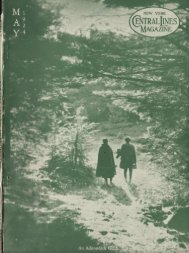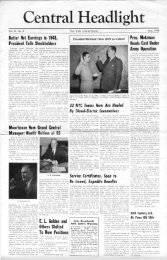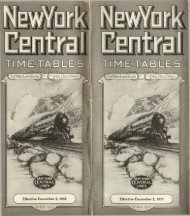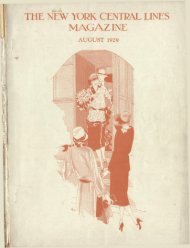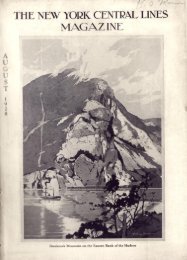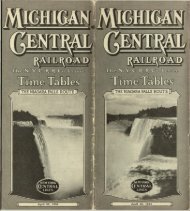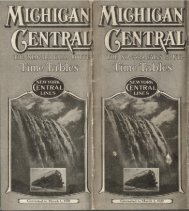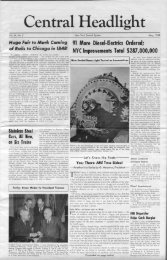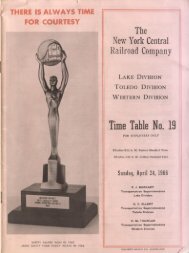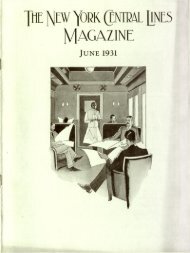You also want an ePaper? Increase the reach of your titles
YUMPU automatically turns print PDFs into web optimized ePapers that Google loves.
24<br />
Ernest Fisher, Terre Haute, ploye of the New York Central. Now,<br />
after thirty years as Baggage Master<br />
Retires from Big Four<br />
at Seneca and fifty years as a New<br />
RNEST FISHER, better known to York Central employe, Mr. Riley is<br />
E his fellow workers as "Pete," retiring to a well-merited rest.<br />
washed his last locomotive boiler at He started as a section hand on the<br />
Duane Enginehouse, Terre Haute, Geneva-Lyons section which he helped<br />
Ind., March 31, to build. Later he succeeded P. H.<br />
after thirty-eight Burns as Baggage Master at Seneca<br />
years of faithful Falls. Since that time, a local stat<br />
service on the Big istician has figured that "Patsy" has<br />
Four Railroad. unloaded 153,000 trains and more than<br />
Mr. Fisher was 2,500,000 parcels of baggage. He has<br />
born in Germany, swept out the station 22,000 times and<br />
March 13, 1858. built more than 8,200 fires to keep the<br />
At the age of public warm.<br />
t w e n t y-two he<br />
came to America,<br />
J. F. Eidmann Remains True to<br />
locating in Terre<br />
Haut e, on the<br />
Road<br />
banks of the HOUGH retired, John F. Eidmann<br />
Wabash, where Twill still serve the New York Cen<br />
he has since made<br />
tral. He writes:<br />
Ernest Fisher his home.<br />
"The New York<br />
He started in the railroad game<br />
Central will con<br />
with the old Vandalia Railroad in<br />
tinue to have my<br />
1882, and after seven years' service<br />
active interest<br />
with that road he came to the Big<br />
and co-operation<br />
Four, which was then known as the<br />
and if at any<br />
Indianapolis & St. Louis, in Septem<br />
time I find it posber,<br />
1890, and he has been with this<br />
sible to furnish<br />
company ever since. During his serv<br />
information that<br />
ice he has served as engine wiper,<br />
will be of assist<br />
hostler and boiler washer.<br />
ance in obtaining<br />
Mr. Fisher has been a steady work<br />
business, I will<br />
er and enjoyed good health. On the<br />
make it a point to<br />
day of his retirement he was present<br />
do so."<br />
ed with a fine traveling bag and a<br />
A native of<br />
bouquet of flowers by his fellow J. F. Eidmann Kingston, N. Y.,<br />
workers.<br />
Mr. Eidmann entered railroad service<br />
in 1885 on a construction train out of<br />
"Patsy" Riley Leaves Service at<br />
Kingston. During 1887 he was a<br />
Seneca Falls<br />
wiper on the Wallkill Valley Railroad<br />
HEN Seneca Falls was a "wood and was later promoted to fireman.<br />
Wing station" for locomotives, Pat In 1889, he transferred to the West<br />
rick Riley was already a veteran em- Shore Railroad and has been on the<br />
New York Central Lines Magazine for May, 1928<br />
River Division as fireman and engineman<br />
ever since. Mr. Eidmann makes<br />
his home at 933 Danielson Street,<br />
North Bergen, N. J.<br />
West Shore Man Retires<br />
ONRAD C. HEINECKE, Night<br />
C Assistant Foreman in the Weehawken<br />
Car Department on the River<br />
Division, having<br />
reached the age<br />
of seventy years<br />
on March 5, was<br />
retired on pension<br />
on March 31.<br />
Mr. Heinecke<br />
began his career<br />
with the New<br />
York Central as<br />
a car cleaner<br />
June 5, 1902, and<br />
has had unbroken<br />
service until the<br />
date of his retirement.<br />
He was<br />
Conrad Heinecke advanced to car<br />
repairer, then inspector, and on February<br />
1, 1907, he was promoted to<br />
Assistant Foreman and held this position<br />
since.<br />
On April 2 Mr. Heinecke was presented<br />
with a wing arm chair, a watch<br />
chain and a ten dollar gold piece by<br />
his associates for which he thanked<br />
the boys in his straightforward way,<br />
admonishing them all to cling to the<br />
Safety habit in the pursuit of their<br />
duties.<br />
She Never Saw One<br />
Trying to be brutally frank to a<br />
flapper, we told her that her hair<br />
looked like a mop.<br />
"What does a mop look like?" she<br />
asked.<br />
Forty-seven years of Big Four service were culminated In a triumphal trip from Peoria to Indianapolis April 1 when<br />
Charles C. Carey, Englneman, drove a gaily bedecked engine on his farewell run before being retired at the age of seventy.<br />
Friends, fellow employes and officers of the road greeted him as he left the Union Station at Peoria and again when he<br />
pulled into his home city, Indianapolis. Conductor George Clark and Fireman L. Lawhorn, his team-mates on the trip,<br />
are shown with him in the picture.<br />
New York Central Lines Magazine for May, 1928 25<br />
Eating T o Live B y Choosing Proper Foods<br />
I<br />
T was breakfast time. At the<br />
table next to ours, in a famous<br />
restaurant in Hollywood, a man<br />
thought he was eating his breakfast—<br />
which he was—but in so doing he was<br />
also committing a crime. Not that<br />
eating breakfast in general is to be<br />
branded criminal, but in some instances<br />
it is, and this was one of them.<br />
The criminal was the man and the<br />
victim was also himself.<br />
"Some breakfast that baby's eating,"<br />
commented the gentleman with<br />
whom I was having a "breakfast conference."<br />
"Do you suppose he'll eat<br />
any lunch?"<br />
"Yes," I replied without hesitation.<br />
"And he'll probably choose a menu as<br />
atrocious as the one he now is falling<br />
upon."<br />
I glanced over at the table again<br />
and mentally noted the array of food.<br />
A cereal was disappearing. Next<br />
there was a stack of wheat cakes<br />
which I watched the man smother in<br />
rich syrup. There was toasted bread<br />
made from wheat flour and on a platter<br />
at his right there was a huge Tbone<br />
steak. When I glanced over at<br />
him fifteen minutes later he was swallowing<br />
the last of the wheat cakes,<br />
leaving the dishes in front of him<br />
empty and clean. Then he rose and<br />
walked away, blase and stupid, intoxicated<br />
with food.<br />
This business of eating has gradually<br />
been undergoing a change until,<br />
in the present era, it has been changed<br />
from an elemental physiologic function<br />
to a baneful vice. Instead of<br />
eating to live many of us now live to<br />
eat. That comment inspires a word<br />
of counsel to those falling into the<br />
latter class. It is: Eat heartily while<br />
the chance is there for it won't last<br />
long. The life insurance people know<br />
that and act accordingly. Our crime<br />
lies in eating too much of the wrong<br />
things and none of the things that we<br />
should eat.<br />
Food for Fuel and Repair Work<br />
But let us leave the unhappy subject<br />
of the fate of those who eat their<br />
way to heaven and instead discuss<br />
some of the elemental facts concerning<br />
this business of eating.<br />
The original purpose is obvious<br />
enough. We eat to stoke the fires of<br />
life and to repair that which the wear<br />
and tear of time have worn off. But<br />
to do so intelligently we should know<br />
something about the requirements<br />
both as to quantity and quality. Most<br />
of us know that it is quite easy to<br />
choke a fire with too much fuel and<br />
we also know that it is not feasible<br />
to fire a furnace successfully with<br />
sand or scraps of iron. The same<br />
dogma applies in firing the human<br />
furnace. If we want to extinguish<br />
the fires of life we can choke them<br />
with too much food, and unless we<br />
feed them the right kind of fuels the<br />
physiologic processes of life are not<br />
going to carry on in a normal manner.<br />
To discuss the quantity and<br />
quality of food necessary for properly<br />
carrying on the processes of life is<br />
By Dr. G. Ellington Jorgenson<br />
the purpose of this and the succeeding<br />
articles.<br />
Before it is possible intelligently to<br />
discuss the quantity and balancing of<br />
the food intake the various important<br />
body requirements found in food must<br />
be understood. Hence food qualities<br />
will be discussed first.<br />
The Five Types of Food<br />
There are five important food factors<br />
necessary for continuation of life.<br />
They are carbohydrates, fats, proteins,<br />
mineral substances and vitamins.<br />
Added to that there is an important<br />
state of body being which is<br />
dependent upon the foods eaten. It<br />
is the reaction of the tissues and tissue<br />
fluids. Normally the fluids and<br />
tissues of the body are and remain<br />
within certain limits of alkalinity.<br />
Any very marked.variation from this<br />
arbitrary point of alkalinity is antagonistic<br />
to life and may cause death.<br />
Let us first consider the carbohydrates<br />
and fats. The former are<br />
composed of all the sugars and<br />
starches; the latter are all the animal<br />
and vegetable oils and fats found<br />
in food. The role played by these<br />
substances is to provide heat and energy.<br />
In the process of burning in<br />
the body they give off heat and energy.<br />
Thus they are the power by which we<br />
accomplish things and by which we<br />
are kept warm.<br />
In burning they are reduced mainly<br />
to water and carbon dioxide. The latter<br />
is an acid gas which we get rid of<br />
by exhaling; in other words this waste<br />
product is eliminated mainly through<br />
the lungs. If the quantity of carbohydrates<br />
and fats is equal to the<br />
amount of energy and heat required,<br />
a balance is struck. If we eat more<br />
of these foods than we need for heat<br />
and energy they are changed into fats<br />
and stored in and upon the body.<br />
Thus we gain in weight and become<br />
fat.<br />
The proteins are foods rich in nitrogen<br />
and, in varying quantities,<br />
phosphorus and sulphur. These foods<br />
are composed of the meats, fish, eggs<br />
and legumes (peas and beans). It is<br />
from these foods that the body obtains<br />
materials with which to repair<br />
itself. Obviously a certain quantity<br />
of these foods is necessary for maintaining<br />
a normal body, and this quantity<br />
varies, depending upon the oc-<br />
The original Morrissanla Station on<br />
the New York & Harlem Railroad,<br />
from the photograph collection of<br />
Randall Comfort.<br />
cupation of the individual concerned.<br />
The protein requirements of the body<br />
are quite small; even in the face of<br />
moderately strenuous exercise. In<br />
fact, they are far less than what is<br />
usually consumed by the average person<br />
who eats meats or allied foods<br />
three times a day.<br />
As in the case of the carbohydrates<br />
and fats, the proteins are reduced to<br />
simpler compounds within the body.<br />
That which is needed for repairing<br />
the effects of time and work is used<br />
and the residue burned, in the main,<br />
into water and the respirable acid gas,<br />
carbon dioxide. But, as also is the<br />
case in the instance of carbohydrates<br />
and fats (fats especially) there is<br />
always some ash left over from the<br />
proteins burned. Again we may, for<br />
illustrative purposes, mention the old<br />
family furnace. In firing a furnace<br />
we have learned (in addition to the<br />
patience-sapping monotony of wielding<br />
a coal shovel) that although most<br />
of the fuel burns into gases that flow<br />
out through the chimney, there is always<br />
a residue of ash left which must<br />
be carried out. The same applies in<br />
the burning of foods in the body.<br />
There is always an ash residue left<br />
over which must be cast off by the<br />
body.<br />
Minerals for the Human System<br />
The mineral requirements of the<br />
body are a subject that of late has<br />
claimed the attention of many workers,<br />
and there is still much to be<br />
learned about the role of mineral salts<br />
and the quantity necessary for maintaining<br />
a normal body. But there is<br />
already adequate evidence clearly to<br />
prove that they are necessary. There<br />
are a number of reasons, but there<br />
are two reasons which the average<br />
layman can readily understand. The<br />
tissues and bones are composed of<br />
highly complex substances in which<br />
the inorganic elements such as iron,<br />
sulphur, calcium, potassium, sodium,<br />
iodine, phosphorus, etc., are important<br />
component parts. That is one reason.<br />
Another pertains to the reaction of<br />
the body fluids and tissues. It has<br />
previously been intimated that the tissue<br />
fluids are kept at (or near) a<br />
certain definite point of alkalinity.<br />
This is maintained by the available<br />
mineral salts.<br />
The vitamins are substances concerning<br />
which we as yet know little<br />
save that they are absolutely essential<br />
if the well-being of the body and its<br />
growth are to be maintained. They<br />
will be discussed more in detail a little<br />
later.<br />
The fixed point of alkalinity of the<br />
tissues and tissue fluids, which has<br />
previously been mentioned, can be<br />
maintained if foodstuffs that are alkaline<br />
in their end-ash products are consumed<br />
in quantities to balance and<br />
thus neutralize the acids produced by<br />
foods that are acid in their end-ash<br />
products.<br />
With this brief discussion of the<br />
various types of foods, food accessories,<br />
their purpose and fate after<br />
being consumed, we are now in position<br />
to understand better a discussion





